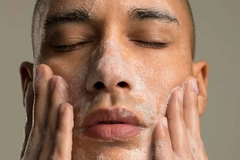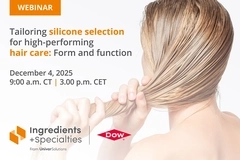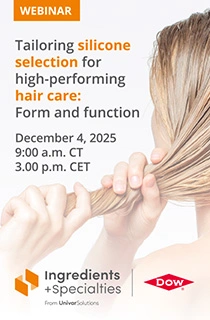Haut.AI CEO breaks down how Face Analysis 3.0 transforms accuracy in skin scans
Key takeaways
- Face Analysis 3.0 provides precise, AI-powered skin assessments, distinguishing between deep wrinkles, freckles, sunspots, and other skin imperfections using smartphone selfies.
- Brands can leverage the technology for personalized, clinically validated skin care solutions, enabling targeted product recommendations and remote efficacy testing.
- The Skin Atlas system ensures privacy while maintaining accurate data, anonymizing user images to safeguard identity without compromising analysis integrity.
Haut.AI’s Face Analysis 3.0 has become its most advanced skin assessment system. It can distinguish between deep wrinkles, fine lines, freckles, sunspots, and other skin imperfections.
Face Analysis 3.0 delivers clinical-grade skin insights using smartphone selfies. The technology offers data-driven personalization, product testing, and privacy-safe AI. It is designed for use by brands, dermatologists, researchers, and everyday users.
Haut.AI’s CEO and co-founder, Anastasia Georgievskaya, tells Personal Care Insights how beauty brands and consumers can leverage the new technology to deliver accurate and personalized cosmetics.
What improvements distinguish Face Analysis 3.0 from previous versions in terms of accuracy or technology?
Georgievskaya: Firstly, we’ve completely updated all of our AI algorithms. With this release, we can now analyze over 29 distinct skin parameters, and this number will continue to grow as our models evolve.
The second major leap is in the level of granularity. Instead of simply identifying ‘lines’ or ‘spots,’ Face Analysis 3.0 can now differentiate between fine lines, deep lines, glabellar lines, and marionette lines. The same applies to pigmentation — we can distinguish freckles, melasma, sun spots, and moles — as well as to breakouts, where we now detect different types of acne, and we also have redness–irritation mapping. We can also now count the exact number of pores and identify enlarged pores. In other words, our algorithms have become significantly more detailed.
Another major enhancement is our LIQA (Live Image Quality Assurance) technology, which helps users capture optimal images for accurate analysis. LIQA now supports multi-angle imaging — what we call Face180° — analyzing the face from three sides to reduce blind spots and deliver up to 30% more consistent results.
We’ve also redefined our scoring system. Previously, our models provided an overall score for each parameter. Now, working in collaboration with researchers, we’ve introduced a new scoring approach that differentiates between fundamental skin state changes and subtle, progressive improvements. Each measurable skin parameter now includes:
- Grades of severity (1–5): Dermatologically aligned, clinical-style assessments that classify changes between skin states, ideal for consumer apps, e-commerce, and clinical evaluations.
- Scores (1–100): Precise numerical measurements that capture subtle variations and micro-improvements, allowing for detailed tracking over time and between product uses.
This structure makes results far more transparent, comparable, and scientifically meaningful across studies, trials, or consumer applications.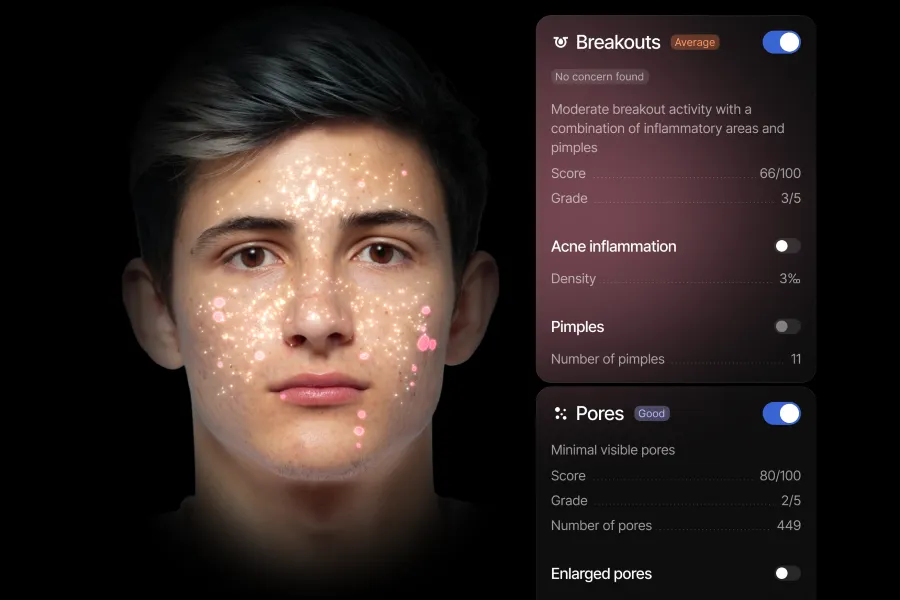 Face Analysis 3.0 delivers clinical-grade skin insights from a selfie.
Face Analysis 3.0 delivers clinical-grade skin insights from a selfie.
The masks that highlight skin concerns have also evolved — they’re more visually refined and also far more precise, pinpointing the exact location and boundaries of each detected condition.
Finally, every image now passes through our patented Skin Atlas system — which anonymizes all personal identifiers while preserving essential skin data.
How can beauty brands utilize technology to enhance their offerings?
Georgievskaya: With Face Analysis 3.0, the biggest advantage for beauty brands is how specific and measurable skin insights have become. The algorithms can now detect a wide range of very precise skin concerns.
This level of detail makes a huge difference in both product development and efficacy testing. When used in remote consumer studies, the system can track visible improvements on individual skin concerns — for example, measuring how a brightening product affects sun spots specifically, rather than pigmentation in general. That kind of targeted validation builds much stronger scientific credibility for brands.
From a personalization perspective, this granularity allows us to go far beyond generic recommendations. Since products are designed to target distinct concerns, Face Analysis 3.0 enables true one-to-one matching between a user’s skin profile and the formulations that best meet their needs. Instead of simply identifying ‘acne,’ we can recognize the type and severity of inflammation, helping recommend products that are clinically relevant for that condition.
How does the Skin Atlas system balance user privacy and scientific integrity when anonymizing facial data?
Georgievskaya: Skin Atlas is our patented anonymization technology, developed to protect user privacy while maintaining the scientific accuracy of skin analysis. We were proud to receive a US patent for this system in 2024, as it represents a real breakthrough in how AI handles facial imagery.
Here’s how it works: when a user uploads an image, Skin Atlas automatically detects facial keypoints and isolates only the skin pixels that are relevant for analysis. Everything else — eyes, hair, lips, and background — is removed and replaced with AI-generated, photo-realistic textures that preserve the face’s structure without any personal identifiers. What’s left is a fully anonymized image that contains only the data needed for accurate skin analysis.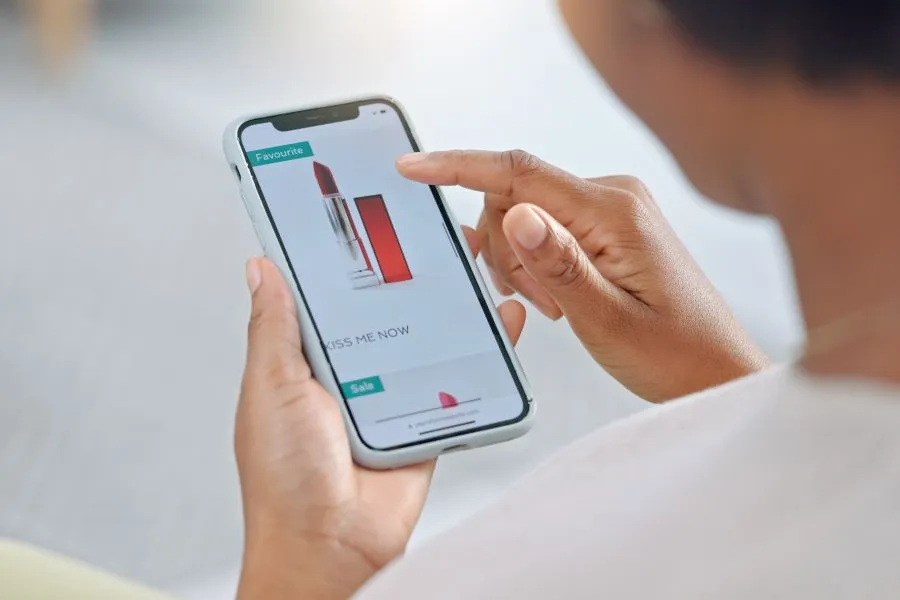 Face Analysis 3.0 provides personalized skin care recommendations based on detailed, clinical-grade analysis.
Face Analysis 3.0 provides personalized skin care recommendations based on detailed, clinical-grade analysis.
This approach is very different from traditional anonymization methods, like blurring or blacking out features, which can actually confuse AI models and reduce accuracy. With Skin Atlas, we maintain the integrity of the skin data while completely protecting user identity.
It’s a system designed to make AI skin care analysis both trustworthy and scientifically sound — ensuring that users can confidently share their images, and that our partners and researchers can rely on the results.
How do you see Face Analysis 3.0 impacting skin care research and brand personalization strategies in the coming year?
Georgievskaya: The real standout of Face Analysis 3.0 isn’t just the new level of precision it brings — it’s that this level of clinical-grade accuracy and granularity can now be achieved with a smartphone camera, capturing insights directly from people’s homes.
That changes everything. Brands can now run large-scale remote consumer studies on product efficacy — reaching far more participants, across different geographies and skin types — using technology they can trust to deliver reliable, reproducible results. This enables richer, more diverse datasets without the need for lab equipment or controlled study environments.
At the same time, consumers can understand their skin on a deeper, more scientific level, tracking changes and improvements over time — all from the comfort of home.
We’re launching with 29 measurable skin parameters, and our roadmap already expands to 40 and beyond as our algorithms continue to evolve. This growing depth of analysis allows researchers to measure subtle improvements — for example, how a brightening serum affects sun spots specifically rather than pigmentation in general — giving brands data they can confidently use to demonstrate real results.
For personalization, Face Analysis 3.0 introduces an entirely new layer of clarity. With our Grades and Masks, even complex skin science becomes understandable and verifiable for end-consumers. When someone buys a skin care product, they don’t have time to decode dermatological terms — they want to know: “Is this product right for me, and why?”
![]() Real-time, precise skin assessments empower dermatologists and researchers alike. Grades (1–5) are aligned with real dermatological classifications, so brands can clearly communicate whether a product matches a user’s specific concern or whether something stronger is needed — and explain why. Masks add a visual layer, showing the exact location and boundaries of each concern, making the analysis intuitive and transparent.
Real-time, precise skin assessments empower dermatologists and researchers alike. Grades (1–5) are aligned with real dermatological classifications, so brands can clearly communicate whether a product matches a user’s specific concern or whether something stronger is needed — and explain why. Masks add a visual layer, showing the exact location and boundaries of each concern, making the analysis intuitive and transparent.
For R&D teams, the detailed Scores (1–100) and precise measurements provide the granularity needed to track subtle, statistically meaningful changes over time. This level of detail enables rigorous product testing, faster iteration cycles, and stronger claims validation across remote or hybrid study designs.
While Face Analysis 3.0 performs exceptionally well using smartphone images, it’s also fully compatible with lab-grade photo capture systems. When used in controlled environments, the precision goes even further — making it a powerful tool that bridges clinical research and real-world application in a way the industry hasn’t seen before.

